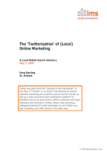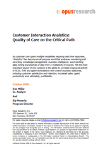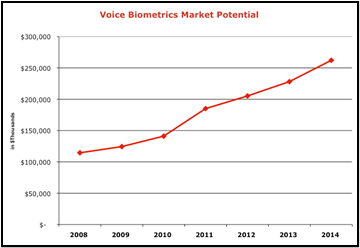One of the banes of phone-based commerce is the phrase, “Your call is important to us.” It tends to be the last thing an inbound customer hears from an IVR system before being put on interminable hold. It would be much more reassuring – and accurate – for an IVR to say that “Your identity is very important to us” and then, rather than indiscriminately placing each call on hold, to treat each caller according to his or her expressed preferences, status, or other known attributes.
customer care
National Australia Bank Launches Customer-Facing Voice Biometric Service

Australia continues to be a hotbed for the latest in voice biometrics announcements. In another widely rumored deployment, National Australia Bank (NAB) has officially launched a voice verification service, making it available to the company’s 3.3 million personal banking customers.
Aimed at “delivering enhanced customer experience and security,” the public deployment comes after NAB ran a successful internal pilot involving 2,000 branch staff in May. The voice biometrics-based service is part of a multi-million dollar effort to upgrade a range of new security functions available to NAB personal banking customers.
According to a company statement, “With identity theft related fraud increasingly moving to the phone channel, the use of voice biometrics enables the effective identification, authentication and verification of customers, offering an extra layer of protection,” said Warren Shaw, executive general manager with NAB Personal Banking.
Successful authentication pilot programs have longed been rumored for financial services organizations, but NAB’s official launch marks the first bank – both in Australia and globally – to go public with a large-scale, customer-facing service. More to come…
Aviva Launches Voice Biometric Capability

Speaking at last month’s Voice Leadership Forum in Sydney, Australia, Paul Magee, managing director with Salmat VeCommerce, predicted “an insurance company and bank are going live with its biometrics technology in the next few weeks.”
True to MaGee’s word, Australian life insurance and wealth management provider Aviva today announced the deployment of a voice biometric service to expedite the process of routing customers to appropriate resources over the phone. Utilizing Salmat VeCommerce’s VeSecure service, callers to Aviva can be quickly verified in order to access all insurance, investment and superannuation products. Enrollment to the service takes approximately two minutes, but Aviva guarantees “subsequent calls will be a faster and better experience.”
In a statement, Frank Lombardo, Group Director Operations at Aviva said, “Voice biometrics is yet another way in which Aviva is improving [customer] experience for both our customers and financial planners.”
Aviva has set up a website page to address frequently asked questions about the voice verification system and includes a prominent mention on the company’s home page.
Aviva Australia, combined with funds management arm Aviva Investors, manages or administers more than AUD$19.2 billion in funds for more than 350,000 customers. Both are part of the global Aviva group, the world’s fifth largest insurance group.
Webcast: “Recombinant Telephony: Conversations from the Cloud”
This on-demand webcast discusses the opportunities that arise at the intersection of VoIP, SIP, Web 2.0 and Social Networking and looks into how cloud-based models simplify self-service, customer care and person-to-person communications. Speakers: Dan Miller – Senior Analyst, Opus Research… Read More ›
The ‘Twitterization’ of (Local) Online Marketing

Featured Research
Twitter has gone from the “margins to the mainstream” in less than 12 months. In so doing it has become an almost essential marketing and customer service tool for brands, as well as a news and information distribution platform for publishers and even government. While companies and larger marketers are flocking to Twitter, there’s also enormous, untapped potential for small businesses to use Twitter as a free marketing and CRM vehicle in the same way.
Advisories are available to registered users only.
For more information on becoming an Opus Research client, please contact Pete Headrick (pheadrick@cgy.bcc.myftpupload.com).
Disaggregation’s Destiny: Recombinant Telephony
Webinar: Cisco’s Mike Bergelson will join Dan Miller and Orange Lab’s Mark Plakias in a webcast, “Recombinant Telephony: Voices from the Cloud” on Wednesday, May 13th (10AM Pacific/1PM Eastern). Held in conjunction with BrightTalk, Click here to register.
In November 2005, in a book entitled “The Pebble and The Avalanche” Moshe Yudkowsky, a physicist who now serves as Chair of the Midwest Speech Technologies Association laid out the tenets of the concept he calls “disaggregation.” Using examples like the growth of the Internet, the introduction of the personal computer and breakup of AT&T, he describes how innovation results when energy is released in busting big things into smaller, more flexible or agile pieces.
He’s right, of course, and the breaking up of monolithic companies, IT infrastructure or political systems releases levels of creative energy that fuel revolution and results in the positive disruption of current practices. Yudkowsky’s era of disaggregation coincides with the Internet-era’s prevailing trend toward “disintermediation.” This “double dis” has resulted in Internet-based communications patterns and Web-based marketplaces where “peer-to-peer” communications put prospective buyers into direct conversations with the people or businesses offering the goods or services that they seek.
Ironically, the era of disintermediation and disaggregation has created a market for new intermediaries and integrators. These are the folks that help put all the pieces back together in new, truly useful ways through a process I’m calling “recombinance.” The result is “recombinant telephony” and it is tightly connected to some major trends and memes like unified communications, collaboration and conversational access.
Reassembly = Recombinance
The word “recombinant” is most closely associated with “DNA,” describing the biochemical bi-product of gene-splicing or the repairing of pieces of DNA as part of genetic engineering. In a way, this scientific method of “recombinance” has become manifest in the second generation of Web services (Web 2.0) where adding a dash of “collective intelligence” with Web infrastructure and easy-to-use development tools or programming languages has led to the rapid development and introduction of new services and modes of communications and eventually business plans.
Twitter, of course, is the most recent example – an immediate message-handling service built loosely on the pieces of SMS, Web services, an online registry and a blogging infrastructure. It has been the inspiration to new modes of search, discovery, customer care and support (with hooks into SalesForce.com’s CloudForce), information dissemination and general entertainment. And as creative Twitter-types develop a set of rich applications that link Twitterers to software and Internet-based services that help them find and interact with other people (or businesses) independent of time, distance and barriers, Twitter can eventually become the dominant mode of communications and commerce for an attention-deprived generation What’s more, this communication will cross all national borders, corporate firewalls and networking constraints.
Recombinance Brings Creativity and Agility to Telecom App Development
Recombinant telephony transcends talk of unified communications and traditional contact center management methodology. In the recombinant world, customer care professionals (or volunteers) can be in their homes or on mobile devices in local coffee shops. From virtually anywhere they can monitor and reply to activity across a number of channels – email, SMS text, websites, blogs and microblogs (meaning all those tweets on Twitter).
The magic is in a well-understood API designed to give third-party developers the tools and hooks into the broadband Internet to fiercely encourage rapid-fire innovation. To point, at eComm2009, held in the Bay Area in March, a number of firms, including IfByPhone, Voxeo, Jaduka, Ribbit (now owned by BT) and Adhearsion showed off their API-support of the developer community. They distribute SDKs with sample code, hold tutorials and fund “BarCamps” or coding sessions that yield very interesting mash-ups like phone-based access to Twitter or speech-enabling Yahoo! Local.
The end-products may sometimes underwhelm, but the speed at which new applications and services are developed, tested, deployed or discarded under the new regimen is stunning. The new architectures and support infrastructures have caught the attention of incumbent carriers and infrastructure providers. BT’s purchase of Ribbit (for US$105 million) is but one example of the value that established network operators see in adding the energy and efforts of aggressive innovators to their resource mix.
Our Menus Have Changed … Really!
The pebble has been dropped. Proprietary systems have been both cracked and benignly hacked. A library of reusable programming elements grows and grows, and, in many cases, it is there to be shared in collaborative efforts. In other cases, the inner workings of systems are exposed for use by all (developers and end-users alike). A dramatic example is Fonolo.com, a company that paid its employees to “power dial” though the IVR systems of scores of big companies so they could map all the branches in each menu. Fonolo.com’s disaggregation efforts now allow customers to select exactly where they want to join a phone conversation with a particular company. No queues, no waiting.
What if companies voluntarily “published” their IVR interactions and made them available to Fonolo.com? The result would be shorter queue times (which equates to lower telecom costs), happier customers and more accurate renderings of the “site navigation” – which is especially important in the rare cases that “our menus have changed” is a true statement.
Recombination is inevitable. Economic and technological imperatives have blown the speech processing, call processing and application processing worlds apart. Creative forces are compelling developers to put them back together in new ways. The results, when we indeed come out of this bad economy, are bound to be beneficial.
Customer Interaction Analytics: Quality of Care on the Critical Path
 As customer care spans multiple modalities requiring real-time responses, “Analytics” has become an all-purpose word that embraces monitoring and recording, knowledge management, business intelligence, word spotting, data mining and analysis of data from a multiplicity of sources. Yet the most important aspect of new systems is the ability to correlate measured activity in ACDs, IVRs and agent workstations with overall business objectives, including customer satisfaction and retention, increased sales, agent productivity and, ultimately, profitability.
As customer care spans multiple modalities requiring real-time responses, “Analytics” has become an all-purpose word that embraces monitoring and recording, knowledge management, business intelligence, word spotting, data mining and analysis of data from a multiplicity of sources. Yet the most important aspect of new systems is the ability to correlate measured activity in ACDs, IVRs and agent workstations with overall business objectives, including customer satisfaction and retention, increased sales, agent productivity and, ultimately, profitability.

